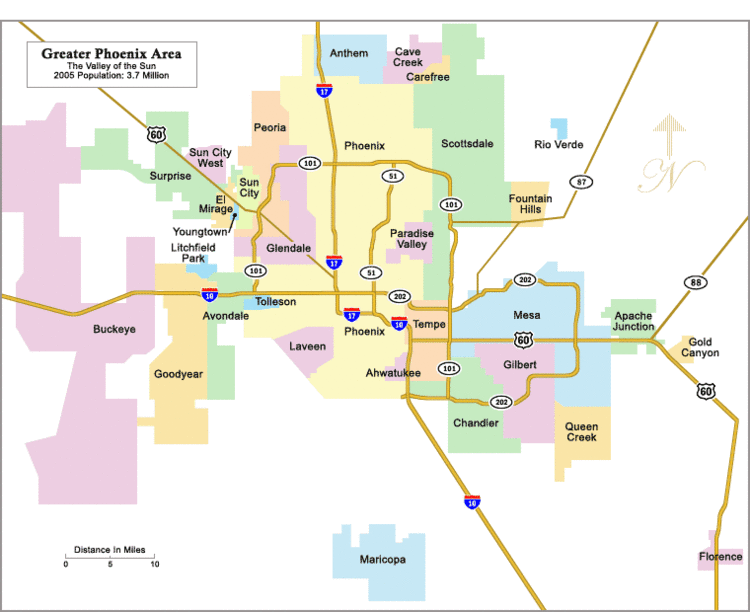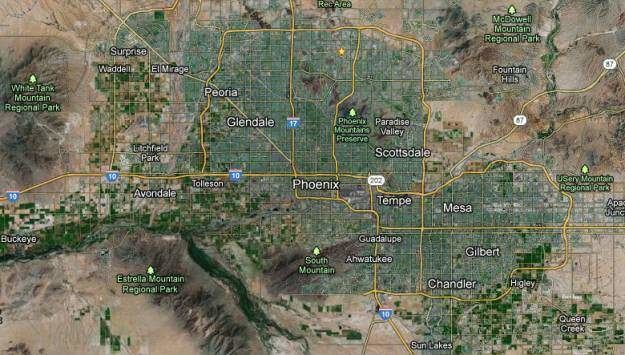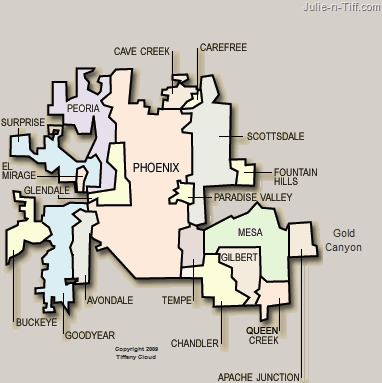Lowest elevation 735 ft (224.03 m) | Highest elevation 2,704 ft (824.18 m) Area 23,494 km² | |
Other Major Cities • Maricopa County - Mesa - Chandler - Glendale - Scottsdale - Gilbert - Tempe - Peoria - Surprise• Pinal County - San Tan Valley - Casa Grande - Maricopa Area codes Area code 623, Area code 602, Area code 480, Area code 520, Area code 928 | ||
Phoenix metropolitan area manhole cover during storm
The Phoenix Metropolitan Area – often referred to as the Valley of the Sun, the Salt River Valley or Metro Phoenix – is a Metropolitan area, centered on the city of Phoenix, that includes much of the central part of the U.S. state of Arizona. The United States Census Bureau designates the area as the Phoenix-Mesa-Chandler Metropolitan Statistical Area (MSA), defining it as Maricopa and Pinal counties. As of the Census Bureau's 2015 population estimates, the Valley had 4,574,351 residents, making it the 12th largest Metropolitan area in the nation by population. The gross domestic product of the Phoenix Metropolitan Area was $215 billion in 2014, 15th largest amongst metro areas in the United States.
Contents
- Phoenix metropolitan area manhole cover during storm
- List of the most expensive streets in phoenix metropolitan area
- Demographics
- Communities in the Phoenix metropolitan area
- Cities and suburbs
- Unincorporated communities
- Geography
- Climate
- Economy
- Freeways and expressways
- Arterial roads
- Street numbering systems
- Rail
- Aviation
- Housing
- References

It is also one of the fastest growing major metropolitan areas, gaining nearly 400,000 residents from 2010 to 2015, and more than 1.3 million since 2000. The population of the Phoenix Metropolitan Area increased by 45.3% from 1990 through 2000, compared to the average United States rate of 13.2%, helping to make Arizona the second fastest growing state in the nation in the 1990s (the fastest was Nevada). The 2000 Census reported the population of the metropolitan area to be 3,251,876.

As for the 2010 Census, the two-county metropolitan area was reported to have a population of 4,192,887. Metro Phoenix grew by 941,011 people from April 2000 to April 2010, making it one of the fastest growing metro areas in the country. This also contributed to the entire state's exceptional growth, as the area is home to just over two-thirds of Arizona's population.

List of the most expensive streets in phoenix metropolitan area
Demographics
As of the 2010 census, there were 4,192,887 people, 1,537,137 households, and 1,024,971 families residing within the MSA. The racial makeup of the MSA was 73.0% White (58.7% White Non-Hispanic), 5.0% Black, 3.3% Asian, 2.4% Native American or Alaska Native (virtually all Native American) and 16.2% of other or mixed race. 29.5% were Hispanic of any race.

In 2010 the median income for a household in the MSA was $50,385 and the median income for a family was $58,497. The per capita income was $24,809.
Communities in the Phoenix metropolitan area

What follows is a list of places in the Phoenix Metropolitan Area (populations as of 2014). The Office of Management and Budget defines a metropolitan area as the core city plus its county and any nearby counties that are economically dependent on the core city. However, Arizona has relatively large counties and a harsh, rugged desert landscape. For these reasons, much of the land that is part of the Metropolitan Statistical Area is rural or completely uninhabited. The core part of the Phoenix Metropolitan Area is the Phoenix–Mesa, Arizona Urban Area, which is far smaller than the Metropolitan Statistical Area.
Places that fall completely or partially within the boundaries of the Phoenix-Mesa, AZ UA are in bold below.
Cities and suburbs
Principal city
Places with 250,000+ inhabitants
Places with 150,000–249,999 inhabitants
Places with 75,000 to 149,999 inhabitants
Places with 30,000 to 74,999 inhabitants
Places with 10,000–29,999 inhabitants
Fewer than 10,000 inhabitants
Unincorporated communities
Over 10,000 inhabitants
Under 10,000 inhabitants
Geography
As of 2010, the Phoenix Metropolitan area consists of Maricopa and Pinal counties, comprising a total area of about 14,600 square miles. Because of the size of counties in Arizona, even though Maricopa and Pinal counties together contain nearly 4.5 million people, most of the area is uninhabited, which gives the MSA an extremely low density compared to other major MSAs in the nation.
The average elevation is about 2,000 feet (610 m), with the highest point being 2,704 feet (824 m).
Climate
The Phoenix Metropolitan area is notable for its warm, desert climate. On average, the area receives about 9 inches of rain annually, with less than 1 inch of snow every decade. In total, the region will see about 32 days of measurable precipitation each year. The MSA is one of the sunniest major metropolitan areas, receiving 295 days of sunshine, compared to the national average of 205. The average July high is about 104 °F (40 °C), with the average January low being about 37 °F (3 °C), still above freezing. Bestplaces gives the Phoenix Metropolitan Area a comfort index of 44/100, which is also the national average.
Below is a chart showing climate data collected from Sky Harbor Airport. Note that due to the vast area covered by the MSA, climates may differ depending on where in the valley you are located.
Economy
The Phoenix Metropolitan area has historically been the center of the state's economy. As with the state of Arizona, the area relied on the 5 C's (copper, cattle, climate, citrus, and cotton) for its economic growth and expansion. However, after World War II, the area entered the manufacturing industry, which spurred the growth of what would eventually be one of the largest urban areas in the nation. Currently, the two largest industries are manufacturing and tourism. About 10 million people visit from other States and Canada each year, due to the area's mild winters and long, sunny days. The technology and service industries currently account for almost 77% of total employment in the region. As well as a strong tourism industry, the Phoenix area has a significant business sector. Several Fortune 500 and Fortune 1000 companies have their international headquarters in the area, including Avnet, PetSmart, Insight Technologies, Apollo Education Group, and Sprouts Farmers Market. Other Fortune 500 companies with significant presence include Banner Health, the state's largest private employer, American Airlines, which merged with Tempe-based US Airways, and Intel, which has a large regional campus in Chandler.
The Metropolitan Area ranks 5th in the nation in economic growth, which is a major comeback from the recession. The unemployment rate of the area is 5.3%, lower than the national rate of 6.3%. It also has slightly higher recent job growth (1.99% compared to 1.18%) and higher projected job growth (38.7% compared to 36.1%). Although the area has significantly higher sales tax rates compared with the nation as a whole (8.3% to 6%), income tax rates are lower than the national average (3.36% to 4.72%). The largest occupation by population is in the office/administrative sector, comprising more than a quarter of all jobs in the region.
Freeways and expressways
The Phoenix Metropolitan Area is served by several controlled-access freeways, including:
Many new freeways are planned to be built in the future, either through upgrades of existing roads such as SR 74, SR 85, and Northern Parkway; or through the construction of new freeways where no road existed before such as SR 24, SR 30, I-11, and the South Mountain Freeway portion of Loop 202.
Arterial roads
Most of the arterial roads in the Phoenix metropolitan area are laid out on a regular grid, following the section lines established in the Public Land Survey System. As a result, arterial roads in cities that had once been geographically separate may have been given different names while occupying the same section line. When these roads were extended to accommodate the growth in the area they eventually merged into a single road while the previous segments retained their existing names. This results in several cases of a road abruptly changing names; for example, Dunlap Avenue in Phoenix becomes Olive Avenue west of 43rd Avenue, in Glendale.
Another quirk of a grid system based upon the Public Land Survey System is due to the occasional corrections in the grid caused by the curvature of the earth. This results in arterial roadways deviating slightly from a straight line, as can be seen in many locations where roads abruptly curve either just north or just south of Baseline Road to follow a new section line.
The majority of the cities in the metropolitan area, as well as unincorporated areas in Maricopa County, observe the addressing system employed by the City of Phoenix. A number of cities, however, retain their own addressing systems with differing reference points, creating the potential for multiple instances of a house number being found on the same named road.
In terms of numbering systems, some roads that continue through multiple cities will switch numbering conventions several times. A drive eastward along Broadway Road, for example, will pass through Goodyear, Avondale, Phoenix, Tempe, Mesa, and Apache Junction, each with their own reference point for address numbering. Though the street does not curve, the direction changes from west to east in each city and back again when moving from one city to the next, causing considerable overlap in numbers.
Street numbering systems
Most communities in Maricopa County use the Phoenix-County numbering system, with the point of origin at Central Avenue and Washington Street. In the Phoenix-County system, north-south numbered roads labeled "avenue", "drive", and "lane" are located West of Central Avenue, while those labeled "street", "place" and "way" are located east of Central Avenue. Starting with 579th Avenue in the west near Tonopah the avenues count down with approximately 8 numbers per mile to 19th Avenue and count up again to from 16th Street to 228th Street near Queen Creek in the east. They go, in order from west to east (although not all necessarily exist):
This has been a source of confusion for some newcomers, who might end up, for example, at 91st Avenue and Thunderbird Road, when in fact they intended to go to 91st Street and Thunderbird Road, between 30 minutes and an hour away from one another depending on traffic.
One beneficial quality of this arrangement for unfamiliar travelers is that the major north-south arterial roads are rarely similarly named; the "avenue" arterials in the West Valley are all odd-numbered and the "street" arterials in the East Valley are even-numbered, with the exception of 7th Ave. & 7th St., both being major roadways running parallel and each one-half mile from Central Ave.
Communities in Maricopa County that have their own street numbering systems include:
Additional confusion can be encountered in Mesa in its urban core, with east-west numbered avenues and drives counting down from 11th Avenue north towards Main Street), and numbered streets and places counting down from 11th Place south towards Main Street. Then, in the eastern part of the city, north-south streets and places count up from 22nd St east of Gilbert Rd, to 112th Street on the Apache Junction border. Also, numerous trailer parks inside the city limits run their own contradictory variations of the numbered street system.
Most communities in Pinal County use the Pinal County street numbering system, whose point of origin is at SR 287 and 11 Mile Corner Road (the intersection of which is known as "11 Mile Corner"). Exceptions include:
Note that Apache Junction continues Mesa's convention of numbered street names by having the north-south sequence continue up from 112th St while simultaneously having east-west numbered avenues south of Apache Trail and east-west numbered streets north of Apache Trail.
Rail
Amtrak's Los Angeles-New Orleans Sunset Limited served Phoenix from 1971 until it was rerouted on June 2, 1996, to a more southerly route between Tucson and Yuma, Arizona, in order to accommodate the Union Pacific Railroad's desire to abandon a portion of its Phoenix-to-Yuma "West Line." This made Phoenix one of the largest cities in the nation without direct passenger service. The designated Phoenix-area stop is in Maricopa, about 40 miles south of Downtown Phoenix.
A light rail system (dubbed the "METRO Light Rail," or "Worm") runs more than 20 miles from suburban Mesa, through Tempe and into Phoenix, traveling through the downtown area, offering access to Phoenix Sky Harbor International Airport and linking two of the four metro area campuses of Arizona State University. The light rail began public operation on December 27, 2008, and it was projected to initially accommodate 26,000 boardings a day, or more than 8 million boardings in its first year. The Valley Metro Rail boardings has experienced constant growth since the beginning. In the year 2012, the light rail boarded just over 14 million people.
Many expansions to the METRO system are currently in the early planning stages, and two are under construction. The Central Mesa extension project, which extends the Main Street line 2½ miles from its current terminus at Sycamore to Mesa Drive in Downtown Mesa, has finished construction and opened on August 22, 2015. The Northwest rail project opened March 2016. The project extended the 19th Avenue track from its former terminus at Montebello Ave to Dunlap Avenue, 3 miles north. Many more extensions are funded, with further projects being studied for feasibility.
Aviation
In 2010, Phoenix Sky Harbor International Airport was the 24th busiest passenger facility in the world and the 10th busiest in the United States, with more than 38 million passengers using the facility. With three terminal buildings encompassing 120 gates, more than 20 airlines offer daily non-stop flights to destinations throughout the world.
The Phoenix-Mesa Gateway Airport started commercial passenger flights in 2004. The airport currently provides service to 39 destinations.
There are several municipal and regional airports in the metropolitan area; however, none of them are currently used by commercial airlines for passenger flights. They include, but are not limited to, Glendale Airport, Phoenix Deer Valley Airport, Phoenix Goodyear Airport, Scottsdale Airport, Falcon Field, Chandler Airport, Buckeye Airport, Phoenix Regional Airport, Pleasant Valley Airport, Estrella Sailport, Stellar Airpark, Skyranch at Carefree, Gila River Memorial Airport, Pegasus Airpark.
Housing
Changes in house prices for the area are publicly tracked on a regular basis using the Case–Shiller index; the statistic is published by Standard & Poor's and is also a component of S&P's 20-city composite index of the value of the U.S. residential real estate market.
